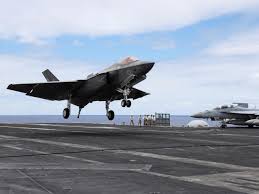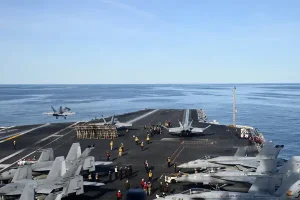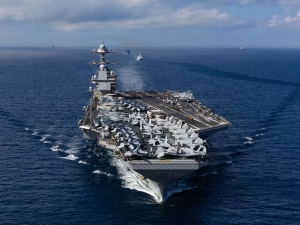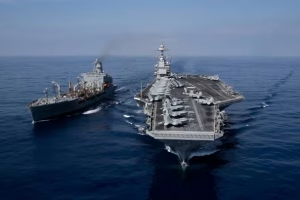Historic Naval Power Projection in Latin American Waters
The United States has initiated one of its most significant military deployments to Latin America in decades, ordering the nuclear-powered super-carrier USS Gerald R. Ford and its accompanying strike group to the Caribbean region. Defence Secretary Pete Hegseth authorised this deployment to enhance capabilities for detecting, monitoring, and disrupting illicit activities threatening American security. This USS Gerald Ford Caribbean deployment represents a dramatic escalation in Washington’s campaign against transnational criminal organisations operating throughout the Western Hemisphere.
The carrier strike group was stationed in Croatia on the Adriatic Sea when the deployment order was issued, meaning the journey to operational waters near Venezuela would require several days. The strategic repositioning transforms the Caribbean into a heavily militarised zone, with the Ford joining an already substantial American force concentration that includes over 6,000 sailors and Marines aboard eight warships currently operating in regional waters.
 Also Read: USS Gerald Ford Caribbean deployment
Also Read: USS Gerald Ford Caribbean deployment
Other: Pakistan’s nuclear arsenal
Unprecedented Military Buildup Targeting Venezuelan Coastline
The USS Gerald Ford Caribbean deployment adds extraordinary firepower to an operation ostensibly focused on counter-narcotics efforts. The carrier could bring nearly 4,500 additional sailors along with nine squadrons of aircraft to the region, creating what military analysts describe as the most formidable American naval presence in these waters since the early 1990s. The Ford measures 1,100 feet in length with a displacement exceeding 100,000 tons, making it the largest warship ever deployed by the United States.
The technological sophistication accompanying this USS Gerald Ford Caribbean deployment cannot be overstated. The carrier utilises electromagnetic aircraft launch systems and advanced weapons elevators that significantly increase operational tempo compared to previous carrier classes. These systems enable the Ford to generate more combat sorties faster and more efficiently than any predecessor, providing commanders with unprecedented flexibility in sustained operations near the Venezuelan coast.
This massive buildup follows a series of lethal strikes against suspected drug-trafficking vessels, with ten boats targeted since early September, resulting in at least 43 deaths. The Trump administration has specifically linked several operations to the Tren de Aragua gang, a Venezuelan prison-origin criminal organisation designated as a foreign terrorist entity. Pentagon officials emphasise that the USS Gerald Ford’s Caribbean deployment aims to dismantle these transnational criminal organisations systematically.
Strategic Implications Beyond Counter-Narcotics Rhetoric
While Washington frames the USS Gerald Ford Caribbean deployment as purely counter-narcotics in focus, the scale and composition of forces suggest broader strategic objectives. President Trump has authorised CIA covert operations in Venezuela and is considering strikes targeting cocaine facilities and trafficking routes inside Venezuelan territory, raising questions about potential regime-change ambitions. The positioning of such overwhelming military capability within striking distance of Venezuela’s northern coastline sends unmistakable political messages to Caracas and the broader region.
Venezuelan President Nicolás Maduro, who faces American narcoterrorism charges, has responded to the USS Gerald Ford Caribbean deployment with defensive measures. Maduro mobilised security forces and civilian militias for exercises along approximately 1,200 miles of Venezuelan coastline, preparing for possible American attacks. The Venezuelan government contends these military operations represent the latest attempt to force Maduro from power rather than legitimate counter-drug efforts.
Recent military activities included flying supersonic heavy bombers near Venezuela’s coast, demonstrating American capability to project power deep into the region. These provocative displays, combined with the USS Gerald Ford Caribbean deployment, create an environment of heightened tension where miscalculation could trigger broader conflict. Regional governments watch nervously as Washington concentrates military assets, suggesting capabilities far exceeding narcotics interdiction requirements.
Regional Diplomatic Consequences and Latin American Reactions
The USS Gerald Ford Caribbean deployment carries profound implications for United States relations throughout Latin America. Countries across the hemisphere view this military escalation with considerable anxiety, recognising that such overwhelming force projection near Venezuela establishes precedents that could affect regional sovereignty norms. The deployment tests diplomatic relationships carefully cultivated over decades, potentially driving some Latin American governments toward alternative security partnerships with China or Russia.


Latin American opposition to interventionist policies runs deep, rooted in historical experiences with American military operations throughout the Cold War era. The USS Gerald Ford Caribbean deployment risks reawakening these sensitivities, potentially undermining diplomatic initiatives the United States has pursued to strengthen hemispheric partnerships. Regional organisations, including CELAC and UNASUR, face pressure from member states to condemn what many perceive as aggressive posturing threatening Venezuelan sovereignty.
Advanced Military Capabilities Transforming Operational Landscape
The technological superiority accompanying the USS Gerald Ford Caribbean deployment fundamentally alters the military balance in the Caribbean basin. The Ford accommodates a crew of nearly 4,600 personnel, approximately 20 per cent fewer than previous Nimitz-class carriers due to more efficient automated systems. This efficiency translates into sustained operational capability without the logistical burdens that limited previous deployments.
The carrier’s embarked air wing includes advanced F-35C Lightning II fighters, E-2D Advanced Hawkeye surveillance aircraft, and MH-60R/S helicopters providing comprehensive maritime domain awareness. These assets enable the USS Gerald Ford Caribbean deployment to conduct simultaneous surveillance across vast ocean areas while maintaining strike capabilities against time-sensitive targets. The integration of unmanned systems further extends the operational reach, allowing persistent monitoring of suspected trafficking routes without exposing personnel to unnecessary risk.
The accompanying destroyers—Arleigh Burke-class guided-missile vessels—provide layered defence against air, surface, and subsurface threats while contributing Tomahawk land-attack missiles capable of striking targets deep inland. This combination means the USS Gerald Ford Caribbean deployment possesses capabilities extending far beyond maritime interdiction, encompassing potential land strikes against infrastructure, command nodes, or production facilities in Venezuelan territory.
Trump Administration’s Domestic Political Calculations
The USS Gerald Ford Caribbean deployment serves multiple purposes within President Trump’s broader political strategy. Demonstrating decisive action against drug cartels addresses a key campaign promise while projecting strength to domestic constituencies concerned about border security and narcotics trafficking. The visible military commitment provides tangible evidence of the administration’s efforts to combat the opioid crisis devastating American communities, even as experts debate the effectiveness of supply-side interdiction strategies.
Congressional oversight of the USS Gerald Ford’s Caribbean deployment remains uncertain. Some lawmakers support aggressive counter-narcotics operations, viewing military force as necessary given the scale of trafficking operations. Others question the legal framework authorising lethal force in international waters and express concerns about mission creep toward regime-change objectives. Budget implications also generate debate, as sustained carrier operations require substantial financial resources that could strain defence appropriations already committed to competing priorities worldwide.
Public opinion regarding the USS Gerald Ford’s Caribbean deployment reflects broader divisions about American military engagement abroad. Supporters emphasise the necessity of disrupting drug flows harming American families, while critics warn against open-ended commitments risking entanglement in complex Latin American political conflicts. The administration must carefully manage these tensions to maintain political support for operations that could extend months or years, depending on strategic objectives and Venezuelan responses.
 International Law and Rules of Engagement Questions
International Law and Rules of Engagement Questions
The USS Gerald Ford Caribbean deployment operates within a complex legal framework governing the use of force in international waters. Strikes against vessels in international waters have resulted in significant casualties without clear attribution to specific criminal organisations before engagement, raising questions about proportionality and due process. International law scholars debate whether counter-narcotics operations justify lethal force absent immediate threats to American vessels or personnel.
The expansion of the USS Gerald Ford’s Caribbean deployment into potentially targeting land-based facilities inside Venezuela would cross significant legal thresholds. Such strikes would constitute acts of war absent Venezuelan consent or United Nations Security Council authorisation. The Trump administration’s legal justification relies partly on designating certain criminal organisations as terrorist entities, thereby invoking authorities traditionally reserved for counterterrorism operations. Critics argue this framework stretches legal boundaries established by international humanitarian law and the UN Charter’s restrictions on the use of force.
Rules of engagement governing the USS Gerald Ford Caribbean deployment remain classified, creating transparency concerns. Human rights organisations demand clarity about targeting procedures, civilian casualty mitigation measures, and accountability mechanisms. The maritime environment complicates these issues, as vessels suspected of drug trafficking often carry crew members who may be coerced participants rather than willing criminals, raising questions about the appropriate use of lethal force.
Economic and Commercial Disruption Across the Caribbean Basin
The USS Gerald Ford’s Caribbean deployment inevitably affects commercial shipping and maritime commerce throughout the region. Heightened military activity raises insurance premiums for vessels transiting Caribbean waters, imposing costs on regional economies heavily dependent on seaborne trade. Port authorities report increased delays as commercial ships undergo additional inspections, disrupting supply chains connecting Latin American exporters with global markets.
Tourism industries across Caribbean islands express concerns that military tensions associated with the USS Gerald Ford’s Caribbean deployment could deter visitors seeking peaceful vacation destinations. The perception of instability, even when actual security risks remain minimal for civilians, influences travel decisions and booking patterns. Regional governments dependent on tourism revenue face difficult choices between supporting American security operations and protecting vital economic sectors.
Fishing communities throughout the Caribbean worry that expanded military operations accompanying the USS Gerald Ford Caribbean deployment will restrict access to traditional fishing grounds or damage marine ecosystems through increased vessel traffic. Small-scale fishermen lack resources to navigate complex military coordination procedures, potentially facing exclusion from waters they have fished for generations. These economic disruptions compound existing challenges facing maritime industries in adapting to climate change and overfishing pressures.
Venezuelan Defensive Preparations and Russian Support
Venezuela’s response to the USS Gerald Ford Caribbean deployment includes bolstering air defence systems and mobilising reserve forces. Maduro claims deployment of thousands of Russian-made surface-to-air missiles across strategic positions, though independent verification of these capabilities remains limited. The Venezuelan military conducts exercises demonstrating readiness to contest American air operations, signalling determination to defend national airspace regardless of technological disadvantages.
Russian and Chinese involvement complicates the strategic environment surrounding the USS Gerald Ford’s Caribbean deployment. Both nations maintain military cooperation agreements with Venezuela, including intelligence sharing, equipment sales, and training programs. The Caribbean deployment risks escalating great power competition in what Washington traditionally considers its sphere of influence, potentially drawing Moscow and Beijing deeper into Venezuelan defence planning.
 Long-Term Strategic Consequences for Hemispheric Relations
Long-Term Strategic Consequences for Hemispheric Relations
The USS Gerald Ford Caribbean deployment establishes precedents that will shape Latin American security dynamics for years. The demonstration that Washington remains willing to project overwhelming military force throughout the hemisphere reinforces perceptions of American hegemony, potentially driving regional governments toward diversifying security partnerships. Countries seeking autonomy from the United States’ influence may accelerate cooperation with alternative powers, fundamentally altering the geopolitical landscape.
The success or failure of operations associated with the USS Gerald Ford Caribbean deployment will influence future American military engagement in Latin America. Achieving measurable reductions in drug trafficking could vindicate the approach, encouraging similar deployments elsewhere. Conversely, prolonged operations without clear outcomes may generate political pressure for withdrawal, limiting options for future administrations confronting security challenges in the region. The Caribbean deployment thus represents a critical test of military solutions to complex transnational problems requiring comprehensive strategies addressing root causes beyond simple interdiction.

